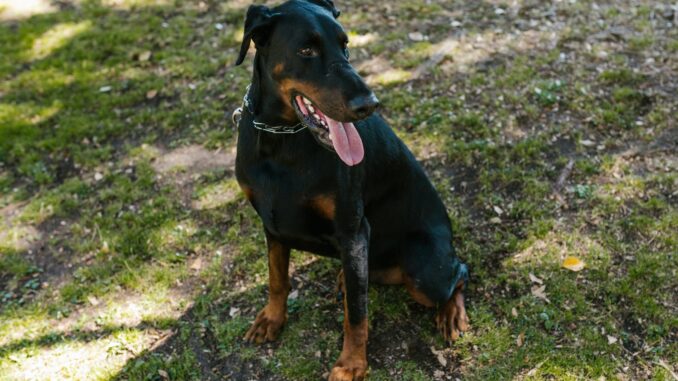
[ad_1]
The Doberman Pinscher, with its striking stance and powerful build, is a breed that commands respect. Known for its intelligence and loyalty, the Doberman is a highly energetic breed that requires a significant amount of exercise to maintain its physical and mental health. A lack of adequate exercise can lead to a host of behavioral problems and health issues. In this article, we will delve into how much exercise is necessary for a Doberman and what types of exercise best suit this noble breed.
1. Understanding a Doberman’s Exercise Requirements
Dobermans are muscular, athletic dogs that require substantial daily exercise. As a general rule, an adult Doberman needs at least one to two hours of physical activity daily. Puppies and young adults may require even more. This exercise should be a combination of both vigorous activity and opportunities for mental stimulation.
2. The Role of Exercise in a Doberman’s Health
Regular exercise is vital for maintaining a Doberman’s muscle tone, preventing obesity, and reducing the risk of cardiovascular issues and joint problems. Additionally, exercise plays a crucial role in mental health, helping to prevent anxiety and boredom, which can lead to destructive behaviors.
3. Puppy Playtime: How Much Exercise for Young Dobermans
Doberman puppies, while energetic, have growing bodies that cannot handle the intense or prolonged exercise that adult Dobermans can. Short play sessions, about 5 minutes for each month of age, several times a day are recommended. As they grow, their exercise can increase in duration and intensity.
4. The Importance of Mental Stimulation
For Dobermans, mental exercise is just as important as physical exercise. Training sessions that challenge their intelligence, puzzle toys, and tasks that require concentration can provide excellent mental workouts. These activities keep their mind sharp and help mitigate potential behavioral issues.
5. Balancing Indoor and Outdoor Exercise
While outdoor exercise is critical for a Doberman’s well-being, indoor activities should not be overlooked, especially during extreme weather. Indoor exercise can include games like hide-and-seek, obedience training, and even treadmill workouts if trained properly.
6. The Best Types of Physical Exercise for Dobermans
The best physical exercises for Dobermans include running, hiking, agility training, and playing fetch. These activities not only help in burning off energy but also strengthen the bond between dog and owner. They can be tailored to suit the individual dog’s health, age, and preferences.
7. The Potential Risks of Over-Exercising a Doberman
Over-exercising a Doberman, particularly a puppy, can lead to joint damage and other health issues. It’s important to recognize the signs of over-exercise, which can include excessive panting, limping, or a decrease in enthusiasm for exercise.
8. Social Exercise: The Benefits of Playtime with Other Dogs
Socializing is an essential aspect of a Doberman’s exercise routine. Interaction with other dogs in controlled environments such as dog parks can provide not only physical exercise but also important social skills. Always ensure your Doberman is well-socialized and under control in these settings.
9. Adapting Exercise to Aging Dobermans
As Dobermans age, their exercise needs will change. Older Dobermans may suffer from joint issues or may not have the stamina for intensive activities. Exercise routines should be adjusted to be gentler and more appropriate for their age and physical condition.
10. Addressing the Doberman’s Need for Speed
Dobermans are known for their speed and enjoy activities that allow them to run. Secure, fenced areas where they can sprint freely or sports like lure coursing can be excellent outlets for their speed.
11. Training as Exercise
Training sessions serve as a form of exercise for Dobermans. Basic obedience training, advanced tricks, or even competitive obedience can keep a Doberman physically active and mentally engaged.
12. The Significance of Consistent Exercise Schedules
Maintaining a consistent exercise schedule helps to manage a Doberman’s energy levels throughout the day. Establishing a routine also provides structure, which is something Dobermans, as working dogs, often thrive on.
13. Weather Considerations for Exercising Your Doberman
Dobermans are sensitive to extreme temperatures. In hot weather, they are at risk of overheating, and in cold weather, they can get cold due to their short coats. Exercise should be adjusted according to the weather, perhaps shifting to cooler times of the day during summer and shorter, more frequent sessions during winter.
Conclusion
Dobermans are powerful, intelligent dogs with a need for regular, structured exercise. Not only does this exercise need to be physical in nature, but it must also engage their minds. By combining different types of activities such as running, agility, playtime with other dogs, and training sessions, you can ensure that your Doberman receives the appropriate amount of exercise to stay healthy, happy, and well-behaved. Always keep in mind their physical limitations and adjust their exercise routine as they age. A well-exercised Doberman is a content and balanced companion, capable of reaching its full potential both as a family pet and as a working breed representative.
Frequently Asked Questions About Exercising A Doberman

1. How much daily exercise does a Doberman need?
A Doberman typically needs between one to two hours of exercise each day. This should be a mix of physical activity like walking or running and mental stimulation through training or interactive play. Adequate exercise is crucial for their health and to prevent behavior problems.
2. Can Dobermans go for runs with their owners?
Yes, Dobermans make excellent running partners due to their high energy and stamina. It’s important to build their endurance gradually and ensure they are well-hydrated and not overexerting themselves, especially in hot weather.
3. Are Dobermans suitable for agility training?
Dobermans are well-suited for agility training as they are intelligent, agile, and willing to work. Agility training provides both physical exercise and mental stimulation, making it an excellent activity for this breed.
4. What are some good indoor exercise options for Dobermans?
Indoor exercise options for Dobermans include playing fetch or tug-of-war, using interactive toys or food puzzles, and conducting training sessions for new tricks or obedience. These activities help keep them mentally and physically engaged when outdoor conditions are not ideal.
5. How can I exercise my Doberman puppy without overdoing it?
Exercise for Doberman puppies should consist of short, regular play sessions that do not put too much strain on their developing joints. Avoid long runs or excessive jumping until they are fully grown and cleared by a vet for more strenuous activities.
6. Do Dobermans need a lot of mental stimulation in addition to physical exercise?
Absolutely, Dobermans require significant mental stimulation along with physical exercise. Puzzle toys, obedience training, and learning new tricks are great ways to keep their minds active and prevent boredom.
7. Is it safe to take my Doberman on hikes?
Yes, hiking is a great activity for Dobermans, providing them with both exercise and mental stimulation. Always ensure they are on a leash or under reliable voice control, and remember to provide them with adequate water and rest as needed.
8. At what age can I start exercising my Doberman puppy?
You can start exercising your Doberman puppy from the time they are fully vaccinated with short walks and play sessions. Gradually increase the duration and intensity of exercise as they grow, typically after they reach around 18 months when their joints are more developed.
9. How do I know if my Doberman is getting enough exercise?
Signs that your Doberman is getting enough exercise include a healthy weight, good muscle tone, and a calm demeanor at home. Lack of exercise may manifest as hyperactivity, destructive behavior, or weight gain.
10. What should I do if my Doberman dislikes exercise?
If your Doberman seems reluctant to exercise, it’s important to rule out any health issues first with a vet check. Then, try to make exercise fun by incorporating games, variety, and treats. Some Dobermans may also enjoy social exercises with other dogs or more engaging activities like scent work or dog sports.
[ad_2]
Source link

Leave a Reply